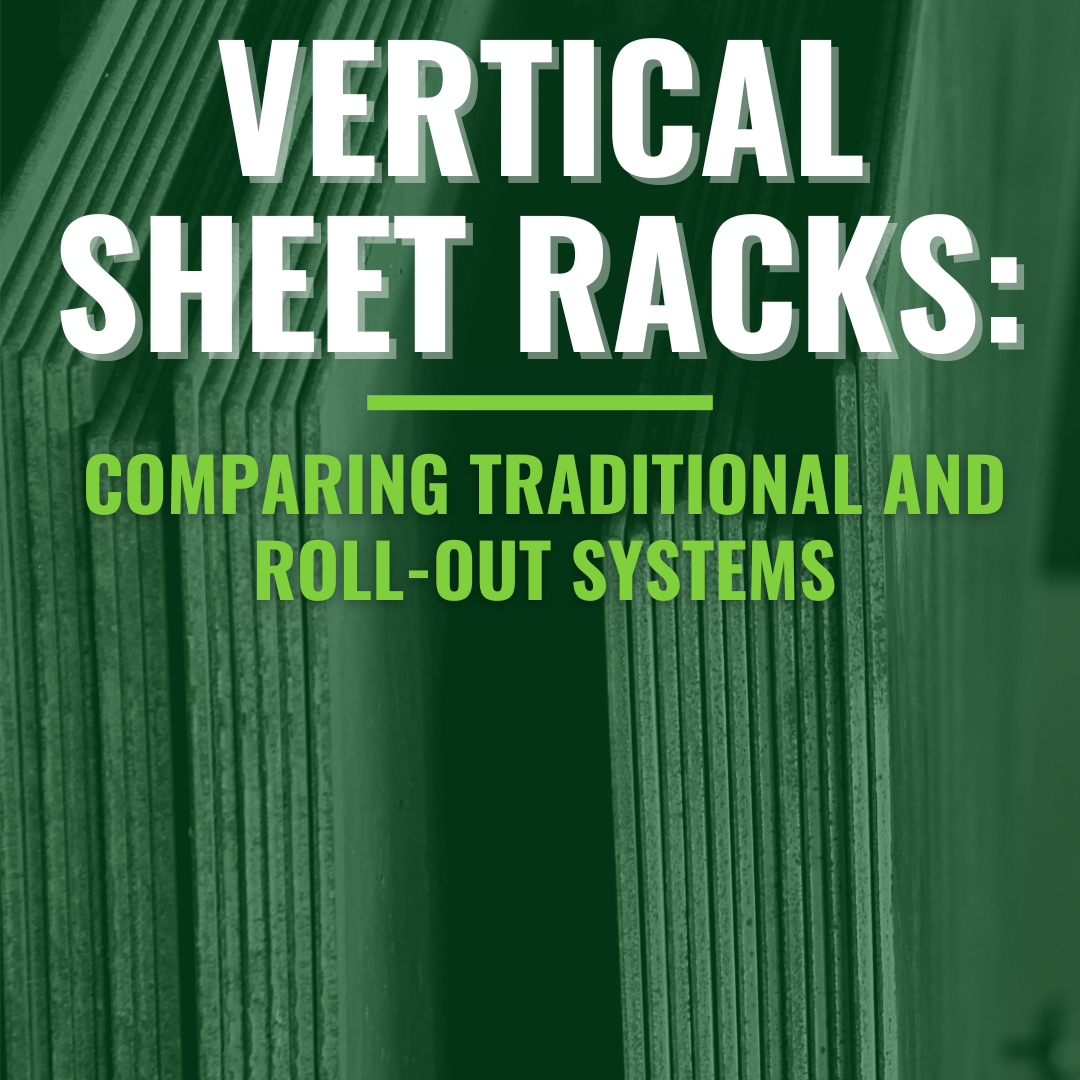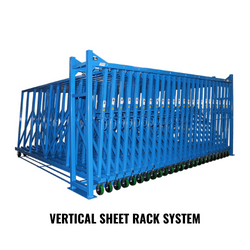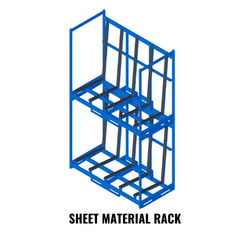We use cookies to make your experience better. To comply with the new e-Privacy directive, we need to ask for your consent to set the cookies. Learn more.
Vertical Sheet Racks: Comparing Traditional and Roll-Out Systems
Sheet metal racking systems can be divided into two broad categories: Bulk and production-level storage. Your bulk storage system holds a large stock of sheet metal, but typically doesn’t allow quick, convenient access (and that access usually requires the use of forklifts or other heavy material handling systems). 
Production-level storage is the opposite. These systems may not store as much product as bulk racking, but they keep sheets close to where they’re used. Ideally, production-level storage provides safe, easy access for consistent line feeding, with or without material handling equipment.
Within the category of production-level sheet metal storage, you have another two options: Horizontal or vertical sheet racks. Given that many operations find vertical storage systems to provide faster, simpler access — especially in the absence of cranes, hoists, or forklifts — this article will drill down one further level to compare two types of vertical, production-level racking for sheet metal.
The final branch on this decision tree leads to two more choices: traditional sheet material racks, which provide support for sheets to stand upright within the system; or roll-out vertical sheet racks, systems of vertical racking that slide in and out of a frame, like a row of drawers.
Here are the benefits and drawbacks of both options, traditional and roll-out vertical sheet racks.
Traditional Vertical Sheet Racks: Pros and Cons
The simplest type of vertical sheet rack stores product upright, between vertical supports that keep sheets from bending or sliding out of place. The supports form multiple compartments, which help to organize product, and these systems provide high-capacity storage within a relatively small footprint.
Benefits of these fixed vertical sheet racks include:
- Quick, simple placement and set-up
- Convenient manual access to sheets
- Improved product organization, for quicker identification and accurate picking
- Relative low cost
- Little to no maintenance
Explore Sheet Material Racks from Solus Group.
However, compared to roll-out vertical sheet racks, these fixed systems come with a few drawbacks:
- Tougher access to sheets for material handling equipment (hoists, cranes, forklifts, etc.)
- Requires a larger footprint for storage of the same volume of sheet metal
- Not always compatible with remnants or non-standard sheet sizes
- Manual handling of sheet metal often requires two or more employees
Despite these disadvantages, vertical sheet storage racks are a popular choice for production lines. In fact, they’re ideal for lighter-throughput scenarios. However, if you have to store a larger quantity of product, don’t have much space, or need more options for access, a roll-out sheet rack might be the better option.
Roll-Out Vertical Sheet Metal Racks: Pros and Cons
Roll-out sheet racks pack dozens of sheet racks into a compact frame. This design leads to a number of advantages that are ideal for production-level storage, including: 
- Racks roll out to expose the face of the sheet, which provides compatibility with material handling systems: sheet lifts, vacuum lifts, hoists, magnets, forklifts, and more
- Compact, high-volume storage (up to 2,000 pounds per rack)
- Space-saving design frees aisles for traffic or other uses
- Remnant storage on lateral support bars
- Frame provides greater protection for stored sheet metal
With a material handling system, a single user can easily pull out a rack and transfer large, heavy sheets, saving on labor costs. Because of the limited footprint, roll-out vertical sheet racks are also ideal for placement on production lines. That improves overall throughput and provides a quick ROI for manufacturing and fabrication operations.
Buy Vertical Sheet Rack Systems from Solus Group.
Of course, roll-out vertical sheet metal racks aren’t the right choice for every scenario. Here are a few of the disadvantages of this choice, as compared to fixed racking:
- Higher initial investment costs
- Moving components require minimal maintenance (but still more than a fixed rack)
- Once in place, roll-out systems are harder to move
As with any infrastructure decision, the best choice for a vertical sheet rack will depend on factors unique to your facility. For help choosing sheet metal storage that provides the best combination of benefits, contact the material handling experts at Solus Group. We don’t just provide equipment; we’ll work with you to design a storage and handling system that’s ideal for your unique application — including working with our manufacturing partners to provide custom vertical sheet racks built to your specifications. Call Solus Group at 314-696-0200 to discuss your material handling challenges today.

